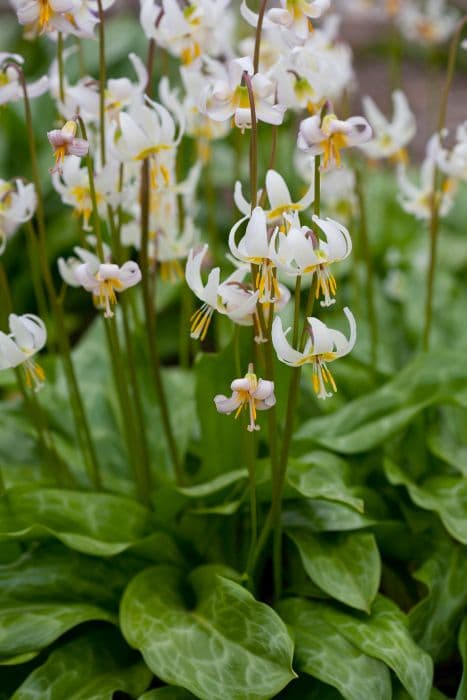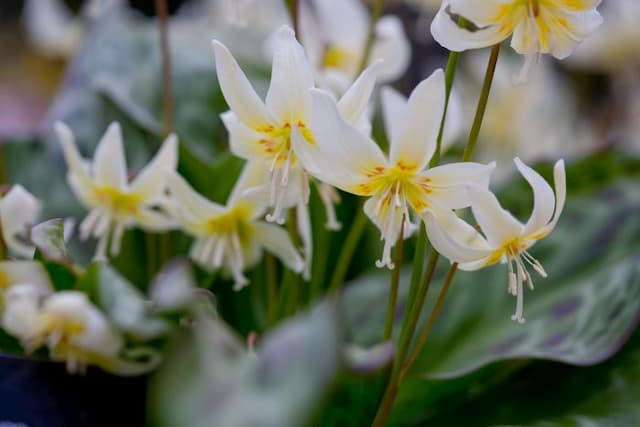Tulip Tulipa 'Dreamland' (5)

ABOUT
Tulipa 'Dreamland', commonly known as the Dreamland tulip, is a stunning variety known for its eye-catching beauty. The tulip typically features large, cup-shaped flowers that have a smooth, lustrous surface. These blooms display a blend of colors with a base of milky-white transitioning to a warm, soft pink hue at the petal edges. The bi-color impact is subtle yet captivating, creating a gentle, romantic appeal in a garden setting or when cut for floral arrangements. The petals of the Dreamland tulip often exhibit a soft, silky sheen which catches the sunlight, enhancing their color gradient. The flowers are borne atop sturdy stems and surrounded by bluish-green foliage. The leaves are lance-shaped, with a slightly waxy texture that helps in water retention. Each stem typically holds a single, prominent flower which becomes the focal point of the plant. During their bloom season, these tulips provide a visual treat, making them popular among garden enthusiasts and landscape designers. The blooms elegantly open in full sun to reveal their inner charm. Dreamland tulips convey a sense of serenity and sweetness, and their overall appearance can breathe life and color into various settings, from traditional garden beds and borders to more contemporary landscape designs.
About this plant
 Names
NamesFamily
Liliaceae
Synonyms
Dreamland Tulip, Garden Tulip, Tulip 'Dreamland'
Common names
Tulipa 'Dreamland'
 Toxicity
ToxicityTo humans
Tulips may pose a risk of toxicity if ingested by humans. The plant parts, specifically the bulb, contain allergenic lactones and other compounds that can cause irritation to the skin and mucous membranes. If the bulb is mistaken for an onion and ingested, it can cause symptoms which often include nausea, vomiting, diarrhea, and abdominal pain. In severe cases, eating large quantities of the bulb can lead to increased heart rate and difficulty breathing. It is important to seek medical attention if any symptoms occur following ingestion.
To pets
Tulips are considered toxic to pets, especially cats and dogs. The plant, particularly the bulb, contains allergenic lactones and other compounds that can irritate a pet's mouth and gastrointestinal tract. Symptoms of poisoning in pets may include drooling, vomiting, diarrhea, and depression. In severe cases, ingestion may lead to an increased heart rate and changes in respiration. If a pet has ingested part of a tulip plant, it is crucial to consult a veterinarian promptly.
 Characteristics
CharacteristicsLife cycle
Perennials
Foliage type
Deciduous
Color of leaves
Green
Flower color
Pink
Height
1-2 feet (30-60 cm)
Spread
1 foot (30 cm)
Plant type
Bulb
Hardiness zones
3
Native area
Central Asia
Benefits
 General Benefits
General Benefits- Enhances aesthetic appeal: The Tulipa 'Dreamland', commonly known as the Tulip 'Dreamland', boasts vibrant and colorful blooms that can beautify gardens and landscapes.
- Attracts pollinators: Tulips can attract bees and other pollinators, supporting biodiversity and the health of surrounding flora.
- Seasonal interest: Tulip 'Dreamland' blooms in the spring, offering seasonal interest and a sign of the changing seasons.
- Easy to grow: This variety of Tulip is relatively easy to cultivate, suitable for gardeners of various skill levels.
- Versatility in landscape design: Tulips can be planted in beds, borders, and containers, allowing for versatile design options in the garden.
 Medical Properties
Medical PropertiesThis plant is not used for medical purposes.
 Air-purifying Qualities
Air-purifying QualitiesThis plant is not specifically known for air purifying qualities.
 Other Uses
Other Uses- Eco-friendly Dyes: Petals of the tulip can be used to create natural dyes for fabrics, offering a spectrum of colors depending on the mordant used.
- Artistic Inspiration: Tulips, with their varied and vibrant colors, can serve as inspiration for artists and photographers looking for natural beauty.
- Edible Garnishes: The petals of tulips can be used as colorful, edible garnishes for salads and desserts, adding a touch of elegance.
- Floral Arrangements: Tulips are commonly used in cut-flower arrangements and bouquets for their long stems and neat flower shape.
- Symbolic Gifts: Tulips often symbolize perfect love and deep affection, making them thoughtful gifts for loved ones on special occasions.
- Education and Research: Tulips can be used in educational settings to teach botany, hybridization, and the history of the tulip mania.
- Guest Attraction: Planting tulips can enhance the appeal of gardens and parks, attracting visitors and promoting outdoor activities.
- Wedding Decor: Tulips can be incorporated into wedding themes, used in bridal bouquets, table centerpieces, and venue decorations.
- Cultural Events: In some communities, tulips are central to festivals and parades that mark the beginning of spring or celebrate local horticulture.
- Photography Sessions: Tulip fields and gardens provide stunning backdrops for professional photography sessions, including fashion and weddings.
Interesting Facts
 Feng Shui
Feng ShuiThe tulip is not typically used in Feng Shui practice.
 Zodiac Sign Compitability
Zodiac Sign CompitabilityThe tulip is not used in astrology practice.
 Plant Symbolism
Plant Symbolism- Perfect Love: Tulips, in general, are associated with perfect or true love, and the 'Dreamland' variety inherits this symbolism due to its enchanting beauty.
- Endless Opportunities: With its lush petals and vibrant colors, 'Dreamland' can represent infinite possibilities and the pursuit of new endeavors.
- Rebirth: As a herald of spring, tulips signify renewal and the cycle of life, and 'Dreamland' is no exception, echoing themes of rebirth and fresh starts.
- Charity: Tulipa 'Dreamland' is often linked to charitable feelings and altruism because of its generous bloom and the joy it brings to viewers.
- Forgiveness: A bouquet of 'Dreamland' tulips could be given to seek forgiveness or to convey a message of understanding, following a long-standing tradition of tulips being associated with making amends.
 Water
WaterTulips generally require moderate watering, and 'Dreamland' tulips should be watered deeply when the soil feels dry to the touch to encourage strong root growth. During the growing season, particularly in the absence of rainfall, they may need water once a week. Typically, aiming for about an inch of water each week, either from rainfall or manual watering, is sufficient. In terms of volume, this can translate to roughly 0.6 gallons per square yard per week. Immediately after planting the bulbs, water thoroughly to settle the soil, but then reduce watering after the blooming period as the foliage begins to die back.
 Light
LightTulips, including 'Dreamland' varieties, thrive best in full sunlight. They should be planted in a location that receives at least 6 to 8 hours of direct sunlight each day. The ideal spot for these tulips is an area where they can bask in the morning sun, as this helps to quickly evaporate moisture from the leaves, reducing the risk of fungal diseases.
 Temperature
TemperatureTulips like 'Dreamland' prefer cooler climates and need a period of winter chilling to bloom properly. They can survive winter temperatures as low as 20°F and have a maximum temperature tolerance of around 65°F. The ideal temperature conditions for their growth and blooming phase are between 50°F and 65°F.
 Pruning
Pruning'Dreamland' tulips do not require extensive pruning, but spent flowers should be deadheaded to prevent seed formation and encourage bulb strength. Pruning back the foliage is not recommended until it has completely yellowed and died back naturally, typically a few weeks after flowering. The best time for pruning is post-bloom when the flowers have faded but the leaves remain green.
 Cleaning
CleaningAs needed
 Soil
SoilThe best soil mix for the Tulip 'Dreamland' should be well-draining and fertile, with a pH level ranging from 6.0 to 7.0. A blend of loamy garden soil, compost, and sand in equal parts is ideal to provide the necessary drainage and nutrients for this bulbous plant.
 Repotting
RepottingTulip 'Dreamland' bulbs should be repotted every year after the foliage has died back. This typically happens in late spring or early summer. The bulbs should be lifted, divided if necessary, and replanted in fresh soil.
 Humidity & Misting
Humidity & MistingTulip 'Dreamland' prefers moderate humidity levels, but they are mostly grown outdoors where humidity is not controlled. Indoors, typical room humidity is sufficient, as precise humidity conditions are not a primary concern for growing healthy tulips.
 Suitable locations
Suitable locationsIndoor
Ensure bright indirect light and cool temperatures for Tulip 'Dreamland'.
Outdoor
Plant in well-drained soil with full to partial sun for Tulip 'Dreamland'.
Hardiness zone
3-8 USDA
 Life cycle
Life cycleTulipa 'Dreamland', commonly known as the Dreamland Tulip, begins its life cycle as a bulb planted in well-draining soil during the fall before the first frost. The bulb lies dormant through the winter, and with the onset of spring, it breaks dormancy and sprouts, producing stems, leaves, and a flowering stalk. The plant blooms in mid to late spring, displaying the characteristic pastel mauve-pink petals with a creamy base that Dreamland Tulips are known for. After the flowers have been pollinated, they will wilt, and the plant will focus energy on seed production. As temperatures rise in early summer, the foliage yellows and dies back as the plant goes into dormancy, reserving energy in the bulb for the next growing season. The cycle repeats yearly, with the bulb either producing offsets for propagation or being divided and replanted by gardeners for multiplication.
 Propogation
PropogationPropogation time
Spring
The most popular way to propagate Tulipa 'Dreamland', commonly known as the Dreamland tulip, is through dividing and replanting its bulbs. Typically, this is done in the fall, after the foliage has died back and the bulbs have entered a period of dormancy. Gardeners should carefully dig up the tulip bulbs and gently separate any small bulblets, which are miniature bulbs that form at the base of the mother bulb. These bulblets can be replanted immediately at a planting depth of about 6 to 8 inches (15 to 20 centimeters) and spaced 4 to 6 inches (10 to 15 centimeters) apart in well-drained soil with good sun exposure. It's important to handle the bulbs gently to avoid damage, as this can affect the subsequent growth of the plant. As the bulbs establish and grow, they will eventually produce the characteristic beautiful blooms of the Dreamland tulip in the following spring.








